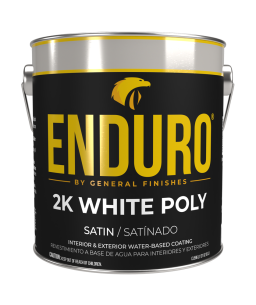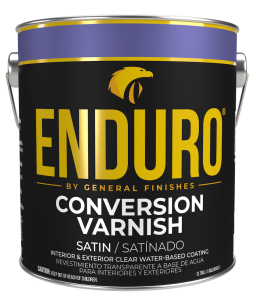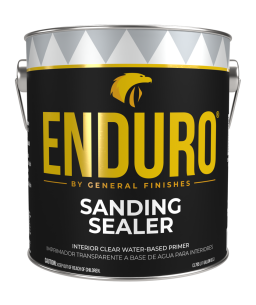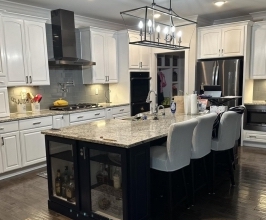We recommend using Colourfal Zero VOC colorants. Other colorant systems should be zero VOC, incorporated at the point of use, and tested thoroughly for performance before application. General Finishes will not be liable for in-can stability when other colorants are used.
Instructions
Step 1: Surface Preparation Enduro Professional Tintable 2K Poly
All wood projects require preparation sanding. If you skip this critical step, your finish may fail.
Raw wood
See our video: How To Prep Sand New Wood
- Sand no finer than 220 grit.
- Remove dust.
Sealed Surface
See our video: How to Prepare Existing Finishes
- Scuff clean with a non-woven abrasive pad & 50:50 mix of denatured alcohol & water.
- Dry 1-2 hours.
- Sand lightly with 220-320-grit sanding sponge.
- Remove Dust
Other substrates such as fiberglass and pre-primed steel
- Can be used with proper preparation & priming.
- Always test for performance before proceeding with your project.
Step 2: Priming
CAUTION: Do NOT use Enduro 2K Clear or any clear topcoat over white paint, as it may cause yellowing.
2K WHITE POLY PRIMING RECOMMENDATIONS:
INTERIOR RAW WOOD: 2K White Poly is designed to adhere to raw wood. Can be used without a sealer.
SEALED SURFACE: When applying 2K White Poly over an existing sealed surface, ALWAYS PRIME with Enduro White Undercoat for interior/exterior use or GF Stain Blocker for interior projects where tannin bleed-through is a concern.
2K CLEAR POLY PRIMING RECOMMENDATIONS:
INTERIOR RAW WOOD & STAINED SURFACES: 2K Clear Poly is designed to adhere to raw wood and newly stained wood. Can be used without a sealer. Use 1-2 coats of Enduro Sanding Sealer for an improved build. 3-4 total coats are recommended.
SEALED SURFACE: If tinted and applying over an existing sealed surface, ALWAYS PRIME with Enduro White Undercoat or Enduro Deep Base Primer for interior/exterior use or Enduro Stain Blocker for interior projects.
Disclaimer
Although Stain Blocker is engineered to prevent the most persistent bleed-through when 2 coats are applied, General Finishes cannot guarantee the prevention of bleed-through or yellowing on every project. Unknown factors and assiduous bleed-through can impact results. Stain Blocker is the most robust option and has performed extremely well in our tests.
Step 3: How To Apply General Finishes 2K White Poly
Enduro Tintable 2K White Poly is a post-catalyzed, high-solids, two-component urethane formulated for ultimate durability and chemical resistance and requires General Finishes Enduro NCO Catalyst. READ PROTECTION INSTRUCTIONS IN WARNINGS SECTION BELOW BEFORE USE.
Join the Enduro Wood Coating Pros Facebook Group at https://www.facebook.com/groups/endurowoodcoatingpros for customer support and learning opportunities specifically for General Finishes Pro line of Enduro products. This group is a great resource for guidance regarding choosing the right product, mastering finishing techniques, troubleshooting, or sharing your finished projects with other pros.
Download 2024 Professional Water-Based Product Catalog Here
Enduro Tintable 2K White Poly Application Steps
- Work in a well-ventilated area.
- Stir thoroughly to reincorporate solids that have settled to the bottom of the can using a power drill and mixer (recommended) or by hand with a paint stick. Do not shake. See this video here: How To Mix 2K Conversion Varnish
- Test for adhesion when applying over an existing finish.
- Thin as desired, with distilled water (after mixing with NCO catalyst); slowly add up to 10% by volume.
- Increase open time, if needed, with 10-15% by volume of Enduro Extender if allowed by local regulations. GF Extender can be used to improve flow and leveling, and increase open time, which is helpful in dry climates. California Residents: Adding more than 2% of GF Extender will make the product non-compliant per SCAQMD Regulations. GF assumes no liability for the improper use of these products.
- Slowly add up to 10% NCO Catalyst by volume (3.2 oz. per quart; 12.8 oz. per gallon) while stirring thoroughly. Mix 2-3 minutes with a power drill. Use gloves and protective eyewear when mixing. Mix only what you are going to use and clean spray gun immediately after use. The finish can only be mixed once, and the leftover product will solidify after 4 hours. Pot life will vary by colorant dosage and manufacturer. DO NOT store in a closed container to avoid pressure build-up.
- Let rest for 15 minutes.
- Apply 2-3 coats or 3-4 total coats if using Enduro Sanding Sealer for an improved build. Additional coats will not improve durability.
- Spray application: Before spraying, strain through a fine-mesh filter. Spray wet films at 3-5-mil thickness. HVLP: 1.1mm-1.3mm spray tip, medium air cap. AIR-ASSIST AIRLESS: 375 PSI pump, 20 PSI assist air, .011”-.013” tip. AIRLESS: Fine Finish .007” - .011”. Verify tip sizes with your equipment supplier. Spray tip recommendations. Keep your gun at a 90° angle, 6-8" from the surface. On large, flat areas, use wet, even patterns 6-8" wide. For narrow surfaces, reduce the fan pattern to 2-3" wide to reduce overspray. Overlap each pass 25% to conceal lines. NOTE; 2K White Poly is used with NCO catalyst. When using a spray gun, wear self-contained breathing apparatus. In the event of insufficient ventilation: Wear self-contained breathing apparatus. When respirators are required, select NIOSH/MSHA-approved equipment and work in a ventilated space. READ ALL PROTECTION INSTRUCTIONS IN THE WARNINGS SECTION BEFORE USE.
- If a faster build is desired over raw wood, use 1-2 coats of Enduro Sanding Sealer, followed by 2 coats of 2K White Poly. No more than 3-4 total coats of finish is recommended.
- Finish sand between coats with a fine-grade (220-320) foam sanding pad or gray non-woven abrasive pad to improve smoothness and adhesion.
- Remove dust with a vacuum, compressed air, an oil-free tack cloth or a water-dampened rag.
Tinting
We recommend using Colourfal Zero VOC colorants. Other colorant systems should be zero VOC, incorporated at the point of use, and tested thoroughly for performance before application. General Finishes will not be liable for in-can stability when other colorants are used.
Warning: Do not use water-based products with Linseed Oils or Danish Oils.
Dry Time 2K Polys
Dry Time Based on ideal conditions of 70°F/21°C; 50% humidity.
Dry-time (touch): 30 minutes
Dry-time (recoat): 30 minutes -2 hours based on heat & airflow.
Cure-time: 5 days
Be sure to allow adequate dry time. You can tell if a water-based finish is dry if it forms a powder when lightly sanded with a fine-grade (220-320) foam sanding pad or 400-grit sandpaper. If in doubt, wait longer. Rushing the dry time can cause "blush," which is clouding in the finish due to moisture trapped between the layers.
Increase dry time if:
- Humidity is over 80%
- Temperatures are cooler.
- 3+ coats are applied
- Thick coats are applied
- Applying over an existing sealed finish
- Applying over products from other brands
- Layering General Finishes water- and oil-based products:
- Water over oil: Let oil-based products dry 72+hr before applying water-based products
- To accelerate dry time in humid conditions, add General Finishes Accelerator and work in a space with good ventilation and air movement. If you decide to re-coat before the recommended time, test dryness.
FORCE DRY: Allow product to flash for 10 minutes at ambient temperature. INFRARED LAMP / OVEN: Heat surface to 105°F/41°C. Allow cooling before sanding. Allow a minimum of 30 minutes between coats.
Buffing 2K
The surface an be buffed after the finish has cured using wet/dry automotive sandpaper. Use GF Satin Finishing Wax as lubricant.
Do NOT use water.
Cleanup For 2K Polys
Clean hands with soap and water. Clean equipment with General Finishes Brush & Gun Cleaner immediately after use.
Disposal
Discard unused product and waste in an environmentally safe manner; check with local fire and health regulations. Do not pour down drains.
Warnings, Personal Protection & Warranties
Compatibility
Do not use water-based products with Linseed Oils or Danish Oils.
Limited Warranty
General Finishes products must be tested to your complete satisfaction before using. General Finishes will not be responsible for color satisfaction, misapplication, nor compatibility with other manufacturers' products. General Finishes will be responsible only for the cost of our products, and not for costs such as labor, damage or project replacement.
Contamination and Compatibility
Our finishes are engineered as a system and are compatible with each other. General Finishes cannot guarantee an ideal refinish when applying our products on top of or combined with another company's products or over surfaces that have been in contact with waxes, polishes or sprays containing contaminants such as silicone. Test for adherence and aesthetics before beginning.
Warning
If you scrape, sand, or remove old paint, you may release lead dust. LEAD IS TOXIC. EXPOSURE TO LEAD DUST CAN CAUSE SERIOUS ILLNESS, SUCH AS BRAIN DAMAGE, ESPECIALLY IN CHILDREN. PREGNANT WOMEN SHOULD ALSO AVOID EXPOSURE. Wear a NIOSH-approved respirator to control lead exposure. Clean up carefully with a HEPA vacuum and a wet mop. Before you start, find out how to protect yourself and your family by contacting the National Lead Information Hotline at 1-800-424-LEAD or log onto www.epa.gov/lead.
FIRST AID:
Seek immediate medical attention if symptoms occur due to the following. EYE CONTACT: Remove any contact lenses. Flush eyes with water for 20+ minutes while lifting upper and lower eyelids. SKIN CONTACT: Wash thoroughly after handling. INHALATION: Move to fresh air and loosen clothing. If not breathing, if breathing is irregular or if respiratory arrest occurs, provide artificial respiration or oxygen by trained personnel. INGESTION: Call physician immediately. Wash out mouth with water. Do not induce vomiting unless directed to do so by medical personnel. Never give anything by mouth to an unconscious person.
Warning
This product contains a chemical known to the State Of California to cause cancer and birth defects. Do not swallow; first aid: drink water to dilute product. May cause eye or skin irritation; first aid: flush eyes thoroughly with water.
Warning
Keep out of reach of children. Avoid contact with eyes. Keep container tightly closed when not in use. Wash thoroughly after handling.
PERSONAL PROTECTION DURING USE:
Hand protection
Chemical-resistant, impervious gloves complying with an approved standard should be worn when handling chemical products if a risk assessment indicates this is necessary. Considering the parameters specified by the glove manufacturer, check during use that the gloves still retain their protective properties. It should be noted that the time to breakthrough for any glove material may differ for different manufacturers. In the case of mixtures, consisting of several substances, the protection time of the gloves cannot be accurately estimated.
Eye protection: Safety eyewear complying with an approved standard should be used when a risk assessment indicates this is necessary to avoid exposure to liquid splashes, mists, gases, or dust. If contact is possible, the following protection should be worn unless the assessment indicates a higher degree of protection: safety glasses with side shields.
Respiratory protection:
Based on the hazard and potential for exposure, select a respirator that meets the appropriate standard or certification. Respirators must be used according to a respiratory protection program to ensure proper fitting, training, and other important use aspects.
Body protection Personal protective equipment for the body should be selected based on the amount and repetition of exposure. It should be approved by a specialist before handling this product.
Environmental exposure controls:
Emissions from ventilation or work process equipment should be checked to ensure they comply with the requirements of environmental protection legislation.
Appropriate engineering controls:
Good general ventilation should be sufficient to control worker exposure to airborne contaminants.
Hygiene measures:
Wash hands, forearms, and face thoroughly after handling chemical products, before eating, smoking, and using the lavatory, and at the end of the working period. Appropriate techniques should be used to remove potentially contaminated clothing. Wash contaminated clothing before reusing. Ensure that eyewash stations and safety showers are close to the workstation location.
Other skin protection: Appropriate footwear and any additional skin protection measures should be selected based on the task being performed.
Specifications
| Basic Features | |
|---|---|
| Product Colors | White, Tintable |
| Base Type | Water |
| Ambering | No |
| Sheen | Flat (10 or less), Satin (25-35), Semi-Gloss (50-60), Gloss (85+) |
| Interior or Exterior | Interior/Exterior |
| Tintable | Yes |
| Type | Urethane |
| Suggested Use |
Interior or exterior application: raw wood, stained wood, cabinets, trim, doors, furniture, table tops & bar tops, fiberglass & pre-primed steel. If using over painted surfaces, especially white, prime and test first before completing your project. |
| Application | |
| Coats | 2 - 3 coats |
| Application Method | Spray |
| Brushable | No |
| Usable over existing finishes | Yes |
| Sprayable | Yes |
| Spray Tip Sizes | HVLP 1.1mm-1.3mm |
| Air-Assist Airless |
375 PSI pump, 20 PSI assist air, .011”-.013” tip or 409 tip. 1000 psi fluid with 18 psi air |
| Airless |
Fine Finish .007” - .011” or Airless .308 FFLP Tip at low pressure |
| Topcoat Required | Self-Sealing |
| Dry Time | |
| Dry Time - Touch | 30+ min. |
| Dry Time - Recoat | 1+ hr |
| Dry Time - Cure | 5 days |
| Dry Time - Recoat - Applied Over Oil Based Product | 72 |
| Contents | |
| Can Sizes | Gallons, 5 Gallon pails |
| Coverage | 450 sq.ft. (41.81 m²) per Gallon |
| Technical Data | |
| Viscosity | Thick |
| Viscosity (cPs) | 1000-1500 |
| Weight Solids | 45% |
| Solids by Weight and Volume |
Solids by weight Flat: 46% Satin: 44% Semi-Gloss: 43% Gloss: 42% Solids by Volume Flat: 35% Satin: 32% Semi-Gloss: 31% Gloss: 30% |
| VOC | <200 g/L. Varies by color. See color-specific SDS for exact number. |
| Durability | |
| Durability (Highest, High, Medium, Low) | Highest |
| Hardness (Koenig #) | 125 |
| Wear (Taber #) | 35.00 mg loss |
| Water (5 max) | 5 |
| Chemical (105 max) | 101 |

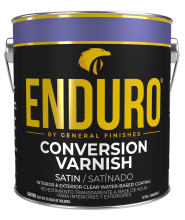 Enduro Water-Based Conversion Varnish
Enduro Water-Based Conversion Varnish
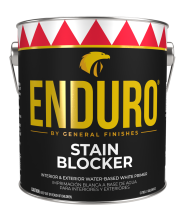 Enduro Water Based Stain Blocker Primer
Enduro Water Based Stain Blocker Primer
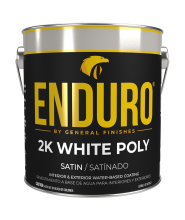 Enduro Water-Based Tintable 2K White Poly
Enduro Water-Based Tintable 2K White Poly
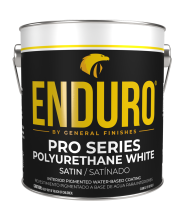 Enduro Water-Based Pro Series White Polyurethane
Enduro Water-Based Pro Series White Polyurethane
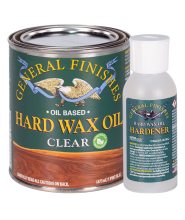 Hard Wax Oil & Hardener
Hard Wax Oil & Hardener
 Gel Stains
Gel Stains
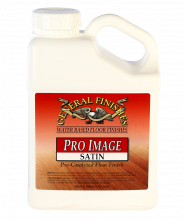 Pro Image Flooring Topcoat
Pro Image Flooring Topcoat
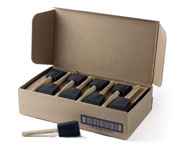 Jen Poly Brushes
Jen Poly Brushes
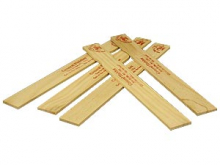 Stir Stix
Stir Stix
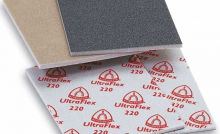 Ultraflex Softback Sanding Sponge
Ultraflex Softback Sanding Sponge
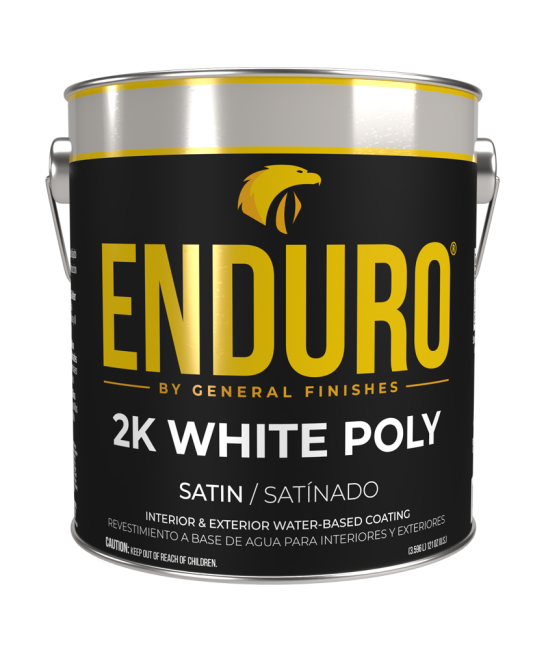
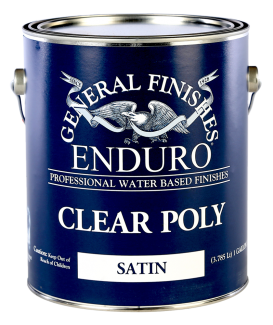
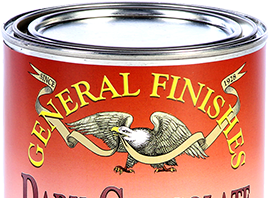
 TDS Enduro Tintable 2K White Poly 2025-07
TDS Enduro Tintable 2K White Poly 2025-07
